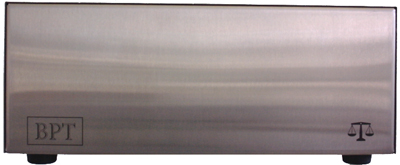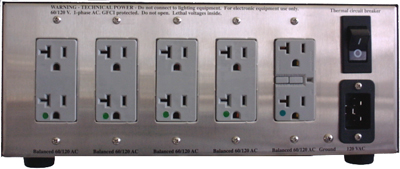|
You are reading the older HTML site
Positive Feedback ISSUE 7 balanced power technologies BP-2 Ultra and BP-2.5 Ultra as reviewed by Francisco Duran
|
||
|
|
I have had a power line conditioner in my system as far back as I can remember. Every device that I have used has brought a more musically pleasing sound, although some have worked better than others. Plugging my gear directly into the wall makes the sound thinner and flatter, and it has more background noise. Also, I need the extra outlets. The PLC of choice for me recently has been the Balanced Power Technology BP-4SE. I bought the unit immediately after reviewing it, about a year ago. I just can't do without the increase in performance that I have gotten accustomed to with it. Chris Hoff of Balanced Power Technology has been busy lately. He has upgraded his power conditioners with numerous internal changes, as well as increasing the number of outlets from eight to ten. The BP-2 Ultra and 2.5 Ultra have the added benefit of special Lo No (ultra-low noise) transformers. One feature that was noticeably absent on the previous models is the IEC socket installed on the rear of the new units, which allows the user the option of using a separate power cord. Chris recommends that his power conditioners be plugged into a 20-amp circuit, but it is not essential—I use a 15-amp circuit. You are also warned that these units draw a rather large amount of current, so a tripped breaker is not uncommon when they are first plugged in. This happened with my 4SE, though once it was in place, it did not happen again. Though I have never plugged my amps into any line conditioner, Chris Hoff recommends plugging your entire system into one of his units, so I removed the BP-4SE and plugged everything into the 2 Ultra. I started listening with my Canary CA-301Mk.II doing the amp duties. After about two hours of watching TV through my system, I heard two sharp buzzes through my speakers. A few seconds later, one of the four Electro Harmonix 300Bs was glowing orange. It was a good thing that I was in the room, and lunged for the off switch. The culprit was a 300B giving up the ghost. After changing to one of my other amps, I sat back to listen to some music. My first reaction was one of surprise. The 2 Ultra not only cleaned up the sound of my amps, but cleaned up my whole system! With either my Monarchy SM-70 or Antique Sound Labs monoblocks, I could hear each amplifier’s character a lot more clearly than before. Wow! Dynamics and details improved on disc after disc, and the improvements were very obvious. The jump in performance also spilled over into the soundstage and imaging departments. The system now got me closer to the reach-out-and-touch-the-performer level on discs that were excellent in recreating the recorded space to begin with. This allowed me to listen into the music with much more ease, and to imagine what the musicians were doing on stage. The bass performance was also more robust and well defined, and I noticed a slight reduction in the brightness of my system. Music didn’t sound bright through the 4SE, but it was less bright with the 2 Ultra, and had a more grain-free background. For comparison’s sake, I took out the 2 Ultra and replaced it with the Brickwall PWBR15AUD, an eight-outlet unit that resides in my son's system. The Brickwall unit imparted a noticeably leaner sound, and the bass did not sound as deep and full. I had previously found the performance of the Brickwall units to be comparable that of others that have been in for review, including the Richard Gray units and PS Audio P300, but with the BPT products, the increase in performance was easily noticeable, and welcome. With the BP-2 Ultra, I found it easier to go home after work, turn on the system, and remain involved in the music. The 2 Ultra (and my 4SE) make music listening for me just a tad sweeter, and this sweetness is what sets these units apart from the power conditioner crowd. I highly recommend the BP-2 Ultra. Unlike some accessories, the improvements they make are easily noted. They have raised the performance of my system to a much more enjoyable level, and that, to me, is what buying a system accessory is all about. The Balanced Power Technology 2.5 Ultra power conditioner showed up on my doorstep on the heels of the 2 Ultra. The 2.5 Ultra provides 20 amps of balanced power, as opposed to 15 amps for the 2 Ultra. Like the 2 Ultra, the 2.5 has ten outlets and uses a Lo No transformer, but the 2.5’s transformer is quite a bit heavier. The review unit was a stock one, except that it had Bybee Quantum Purifiers installed. Quantum Purifiers resemble large black resistors, and come in several sizes for different applications. It is claimed that they reduce various kinds of electrical noise that obscure low-level detail. Could the addition of these little parts make a difference? As I did with the 2 Ultra, I let the 2.5 warm up for two days before substituting it for my BP-4SE. The difference in performance between the two units was instantly recognizable. While the BP-4SE is quite good, the Ultra 2.5 obviously performs at a higher level. It was almost as if I went from a mediocre stereo amp to a pair of high quality monoblocks! I heard improved clarity, along with greater fullness and sweetness. There was a newfound dimension to the music. I heard these qualities with one of my favorite discs, Pharaoh Sanders’ Save Our Children, a recording that possesses great tonal color and very inventive arrangements. The bongo slaps on this CD sounded less artificial and faster than before. Sanders' sax took on a more "organic" quality, and there was an improvement in my perception of an acoustic space. The 2.5 Ultra/Bybee made the music sound more coherent. The different elements fell more naturally into place on the soundstage. There was a tighter, more focused sound, yet at the same time the decay of instruments sounded more relaxed. As Willie Nelson and band played "Milk Cow Blues," it was easier to close my eyes and wander around on the stage. Cymbals sounded more fleshed out and realistic. Willie sang in his usual laidback style, yet the strength in his voice came through. Subtle vocal inflections were easier to hear, along with many other small details. On Sara McLachlan’s Surfacing CD, her voice was clearer, and the lyrics were more easily recognizable. The BPT/Bybee unit helped unravel the music, and made it much more enjoyable. After listening with the 2.5 Ultra/Bybee unit for a while, I switched back to my 4SE. While it was in the same ballpark as far as recreating space, it didn't exhibit the body or fullness of the Ultra 2.5/Bybee, and transients lacked the air, spaciousness, and natural decay they had with the new unit. I also noticed a slight sheen in the upper octaves on massed violins with the 4SE. The 4SE created a dark and silent background for the music to emerge from, but the new unit did it better. The natural bloom of Jack Johnson's acoustic guitar on his CD Brushfire Fairy Tales sounded more atmospheric, with a greater sense of space around the band. Talk about a three-dimensional soundstage! On the song "Drink the Water," the acoustic guitar was stage left, the drums were in the right rear, and the bass guitar was firmly anchored front and center, and there was a very noticeable improvement in soundstage size. When I compared the 2.5 Ultra/Bybee with the 2 Ultra, which lacks the Bybee purifiers, the difference was also quickly noticeable. The most obvious difference was in the way the two units handled the dimensionality of music. The 2 Ultra sounded flatter, and images were less fleshed out. I also heard slightly less separation of instruments. Small details were very slightly diminished, and the decay of instruments didn't quite have the ethereal effect of floating off into the room. Instruments and voices also sounded slightly less natural. I had thought the 2 Ultra was pretty good. It is, but the 2.5 is better. Does the BP-2.5 Ultra/Bybee unit make as big a difference as changing an amp, CD player, or speakers? In my system, it sure did. The 2.5 Ultra brought out the best in my components. Music sounded more real, less mechanical, with a very strong sense of "rightness." There was an increase in detail and dynamics, but the greatest strength of the 2.5 was that with the lowered noise floor, space and dimension took on new meaning. These improvements were quite noticeable, but did not sound exaggerated. Once heard, it was hard for me to go back to the older unit. I am sending my BPT 4SE to Balanced Power Technology for the Bybee Quantum Purifier upgrade just as soon as I can get it to UPS. Francisco Duran
|
|
|
|
2 Ultra 2.5 Ultra Balanced
Power Technologies
|


